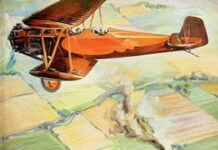1920 was a year for consolidation, after rapid progress in World War 1. Hostilities had taken fixed wing aircraft to new heights and top speeds. Civilians were attracted to their potential for carrying passengers and freight on a commercial basis when hostilities ended.
However the supply of war surplus airplanes dampened demand for new models. But the military were restless because they wanted to retain air superiority in their domains.
Aircraft manufacturers were on the back foot, because they had to be very good to lure funds away from other, peacetime priorities. Many good designs failed that might otherwise have attracted hundreds of orders while war raged.
JANUARY 1920
The French Farman F.70 Light Commercial Aircraft
The French Farman F.70 was a smaller version of the company’s F.60 Goliath airliner / bomber. It was ready for the market by January 1920, and saw service with several airlines although only 20 were built. The main operator was Lignes Farman who operated between Paris, Amsterdam and Brussels, Belgium and purchased five.
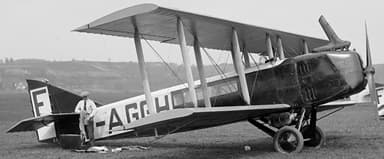
https://commons.wikimedia.org/wiki/File:Farman_F.70_F-AGGH_CIDNA_D%C3%BCbendorf_(rotate,_tight_crop,_grayscale,_contrast).jpg
The Farman F.70 was an unequal-span two-bay biplane with a wooden fuselage and a single engine. The pilot sat up front in an open cockpit, with space for four passengers, or cargo in the fuselage towards the rear. An experimental bomber version did not enter production.
The specification of the Farman F.70 was as follows:
- Length 33 ft, height 11 ft, wing span 49 ft, wing area 576 sq ft
- Empty weight 2,992 lb, gross weight 4,519 lb, crew one, passengers four
- Single Renault 12Fe V-12 piston engine, 300 hp
- Max speed 109 mph, range 250 mi, service ceiling 16,075 ft
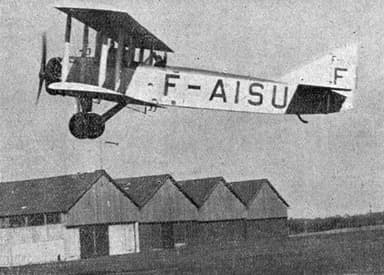
https://commons.wikimedia.org/wiki/Category:Farman_F.70#/media/File:Farman_F.71_L’A%C3%A9rophile_June,1929.jpg
The French Hanriot HD.14 Military Trainer Aircraft
The French Hanriot HD.14 arrived on the scene in the very early 1920’s. Some 2,100 were built during the decade, quite an achievement during a period of relative peace. The French military alone had 1,915. Belgium, Bulgaria, Estonia, Japan, Mexico, Poland, Soviet Union, and Spain also used them.
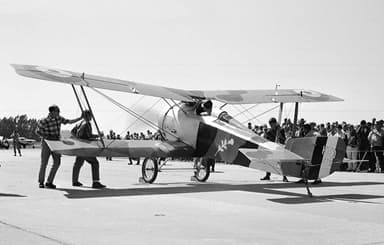
https://commons.wikimedia.org/wiki/File:Hanriot_HD-1_(7108410371).jpg
The Hanriot HD.14 was a conventional, two-bay biplane with un-staggered wings of equal span. Pilot and instructor sat in tandem, open cockpits. An improved version appeared in 1922 with smaller wing area and revised tail fin. The undercarriage was also narrowed so it fitted on an army trailer.

https://commons.wikimedia.org/wiki/File:Hanriot_HD.14_S_L%27A%C3%A9rophile-Salon1926.jpg
The specification of the early Hanriot HD.14 was as follows:
- Length 24 ft, height 10 ft, wing span 36 ft, wing area 370 sq ft
- Gross weight 1,786 lb, engine single Le Rhône 9, 80 hp
- Max speed 68 mph, range 112 mi, service ceiling 13,125 ft
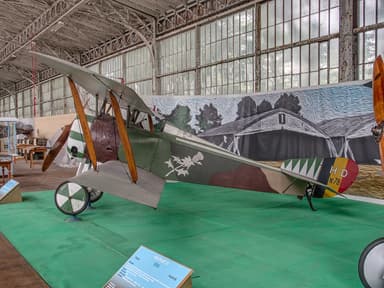
https://commons.wikimedia.org/w/index.php?search=Hanriot+HD.14&title=Special%3ASearch&go=Go&ns0=1&ns6=1&ns12=1&ns14=1&ns100=1&ns106=1#/media/File:Hanriot_HD.1_%E2%80%98No78%E2%80%99_pic2.jpg
FEBRUARY 1920
British metallurgist Alan Griffiths proposes a theory explaining metal fracture or fatigue. This is the process whereby a piece of metal separates into two or more parts when the material fails under stress.
South Africans Pierre van Ryneveld and Quintin Brand set out in a Vickers Vimy from Cairo on February 4, to cross Africa by air from north to south. They arrive in Cape Town slightly more than a month later, after flying approximately 10,000 miles and receive The Times £10,000 award.
Three Italian Caproni Ca.3 bombers and eight Asaldo SVA-9 trainers take off from Rome on February 14 to fly to Tokyo. Two Asalso pathfinders complete the journey, after flying close to 10,000 miles in a month and a half.
American U.S. army major Rudolph Schroeder sets a new world altitude record on February 27, by reaching 33,133 feet in a Packard-Le Peré LUSAC-11 biplane fighter with turbochargers added. He blacks out after his oxygen supply fails, but recovers just in time to land safely.
The British Avro 547 Prototype Triplane Airliner
The British Avro 547 was an experimental airliner based on the highly successful Avro 504 fighter, but with a new, deep fuselage and an extra set of wings. The pilot sat in an open cockpit offset to the left, to accommodate an enclosed cabin for four passengers. The aircraft flew well, however only two prototypes were made.

https://commons.wikimedia.org/wiki/File:Avro_547.jpg
A second, modified prototype – designed to meet British Air Ministry specifications – was less successful and scrapped as slow and unstable in the air. Queensland and Northern Territory Aerial Services (QANTAS) bought the first prototype in November 1920. However, it was unsuited to outback conditions and ended its life as a £2,798 chicken coop.
The specification of the Avro 547 was as follows:
- Length 30 ft, height 14.5 ft, wing span 37 ft, wing area 498 sq ft
- Empty weight 2,077 lb, gross weight 3,000 lb, one pilot, four passengers
- Single, 160 hp engine made by William Beardmore and Company
- Max speed 96 mph, cruise 83 mph, range 230 mi, climb 33 ft per minute

Link to Wikimedia Image
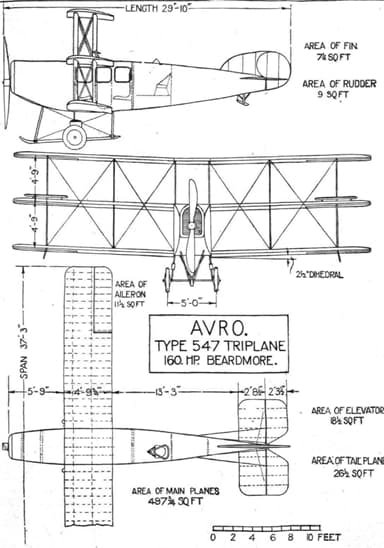
https://en.wikipedia.org/wiki/Avro_547#/media/File:Avro_547_3v_040320_p259.png
MARCH 1920
London moves its main airport from Hounslow to Croyden on March 28. The ornate, gothic-style buildings, in railway station style, house latest technology including the world’s first air traffic control and airport terminal
APRIL 1920
Three Japanese Yokosuka Ro-go Ko-gata type seaplanes fly from Yokosuka, Japan, to Kure, Japan; Chinkai, Korea; Sasebo, Japan; and back to Yokosuka. They fly nonstop for 11 hours 30 minutes on the final leg, thoroughly trouncing the previous world record of 10 hours.
British de Havilland DH.18 Single-Engine Biplane Transport Aircraft
The de Havilland DH.18 was designed and built by Airco in 1919, although it only flew for the first time on April 8, 1920. It was the company’s first purely-commercial venture, although it had mixed fortunes in service.
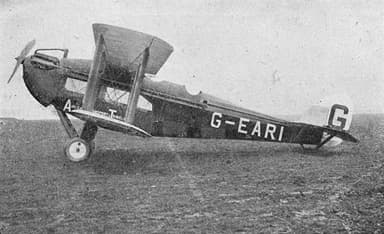
https://commons.wikimedia.org/wiki/File:De_Havilland_DH.18_prototype_G-EARI_Aircraft_Transport_and_Travel_L%27Ann%C3%A9e_A%C3%A9ronautique_1920-1921.jpg
The de Havilland DH.18 used state-of-art technology, having wooden two-bay, wire-braced wings, and a forward fuselage clad in plywood. It accommodated eight passengers in an enclosed cabin with the pilot in an open cockpit behind the cabin. After a series of mishaps three aircraft were leased to Instone Air Line.
Three variants followed, two of which had fuselages that were entirely plywood-clad and had built-in emergency exits. The small fleet delivered generally good service through to 1923 when it retired, after one example had flown 90,000 miles without accident.
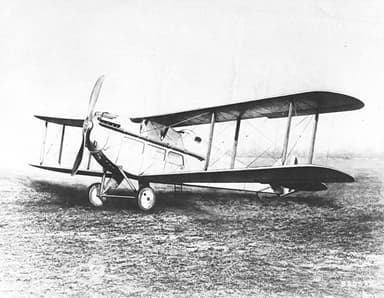
https://commons.wikimedia.org/wiki/File:De_Havilland_DH.18_-_NARA_-_17341558_(cropped).jpg
The specification of the de Havilland DH.18A was as follows:
- Length 39 ft, height 13 ft, wing span 51 ft, wing area 621 sq ft
- Empty weight 4,040 lb, gross weight 6,510 lb, one crew, eight passengers
- Napier Lion 12-cylinder water-cooled W-block aircraft piston engine, 450 hp
- Max speed 125 mph, cruise 100 mph, range 400 mi, ceiling 16,000 ft
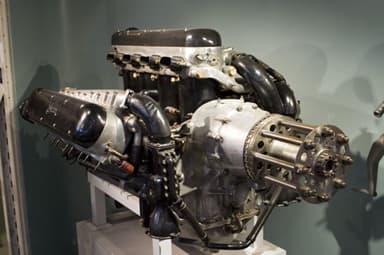
https://en.wikipedia.org/wiki/Napier_Lion#/media/File:CASM_-_Napier_Lion_II_-_030906.jpg
The Napier Potez VIII with Four Wheels and Vertical Inline Engine
The prototype French Potez VIII trainer had several unusual features when it first flew on April 9, 1920. These peculiarities inclined a very unusual vertical inline engine, and a four-wheeled undercarriage on early models. However, the production version was more conventional but the company only managed to sell approximately fifteen.
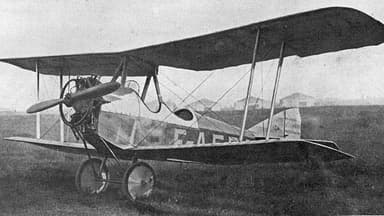
https://commons.wikimedia.org/wiki/File:Potez_VIII_L%27A%C3%A9ronautique_December,1922.jpg
The Potez VIII was otherwise a fairly conventional single-bay biplane, with rectangular plan wings mounted without stagger, but with marked dihedral. The fuselage was flat-sided with wooden structure and plywood skinning, accommodating the instructor and student in tandem open cockpits.
The vertical crankshaft engine was a proprietary design with exposed cylinders pointing forwards for cooling. It had gearing to turn the output through 90° to drive a two-blade propeller. Later versions used Anzani 6A radial engines and these fared quite well in competitions.
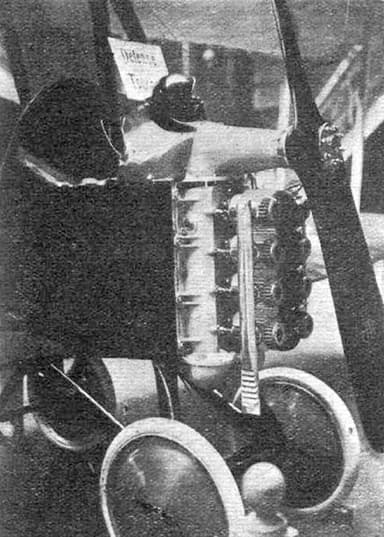
https://commons.wikimedia.org/wiki/File:Potez_A-4_-_Potez_VIII_-_Paris_1919_120220_p179.jpg
The specification of the Potez VIII trainer was as follows:
- Length 19 ft, height 8 ft, wing span 26 ft, wing area 220 sq ft
- Empty weight 728 lb, gross weight 1,224 lb, student and instructor
- Potez proprietary vertical engine, subsequently Anzani 6A radial
- Max speed 90 mph, service ceiling 13,000 ft, fuel capacity 16 US gal
MAY 1920
The Latécoère 4: A Failed Experiment Ahead of Its Time
The French Latécoère 4 was a step change in passenger aircraft way ahead of its time. The fact it handled badly was almost incidental to its vision for the future of fixed wing flight. What made the difference was Marcel Moine and P.G.Latécoère set military convention aside, and redesigned everything from scratch the way they thought it should be.

https://en.wikipedia.org/wiki/File:Lat%C3%A9co%C3%A8re_4_Le_G%C3%A9nie_Civil_December_3,1921.jpg
Few images survive of the precociously modern airplane. However, we do know the passenger cabin entered through a side door, and had tables, armchairs, and sliding windows for thirteen passengers. Three more were closer to the pilot at the end of a 1.6-foot wide companionway.
Unfortunately, Latécoère 4 was a technical flop that flew badly, and was soon discontinued. The wings of the three-engine, two bay biplane had neither stagger nor sweep, but featured an unusually large interplane gap These were made of wood, but the fuselage in contrast was made of metal.
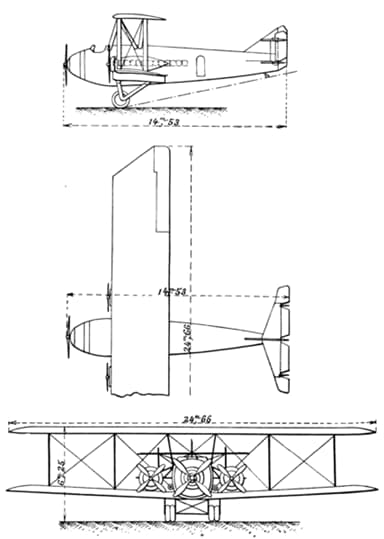
https://commons.wikimedia.org/wiki/File:Lat%C3%A9co%C3%A8re_4_3-view_Le_G%C3%A9nie_Civil_December_3,1921.png
The pilot had an elevated view. But the radio operator and engineer were below and forward of him, at best with a pinch view. The first flight on December 21, 1920 revealed serious instability. The aircraft crashed on the second attempt ten months later. A bomber version emerged from the wreck.
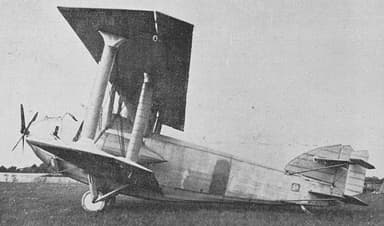
https://commons.wikimedia.org/wiki/File:Lat%C3%A9co%C3%A8re_4_L%27Aerophile_December,1922.jpg
The specification of the modified Latécoère 4 was as follows:
- Length 48 ft, height 20 ft, wing span 80 ft, wing area 1,700 sq ft
- Empty weight 7,970 lb, gross weight 18,387 lb, crew 3, 16 passengers
- Salmson 18 Z 18-cylinder water-cooled in-line central radial engine, 342 hp
- Two Salmson 9 Z 9-cylinder water-cooled radial lateral engines, 250 hp each
- Max speed 120 mph, design range 680 miles
JUNE 1920
U.S. Army Engineering Builds Own VCP-1 Pursuit Aircraft
The United States Army Engineering began designing its own VCP-1 pursuit fighter aircraft, named after the designers’ initials in 1918. The airplane that first flew on June 11, 1920 had a monocoque structure made of plywood, while the wings were of wood and fabric. The engine was cooled with an unusual annular radiator.
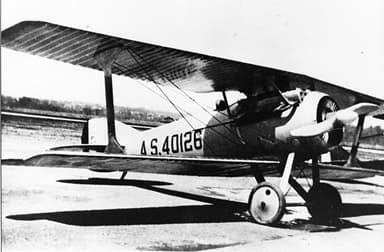
https://commons.wikimedia.org/wiki/File:Ray_Wagner_Collection_Image_(16439295418).jpg
The designers drew inspiration from the French SPAD S.XIII, but made it faster and sleeker. Their choice of Wright-built 300 hp Hispano-Suiza 8 V-8 engine accelerated the single bay biplane to impressive speeds.
They then decided to redevelop it as a racer using a 660 hp Packard 1A-2025 V12 engine with conventional cooling. This VCP-2 also later known as PW-1 achieved 179 mph at the Pulitzer Trophy air-race on November 25, 1920.
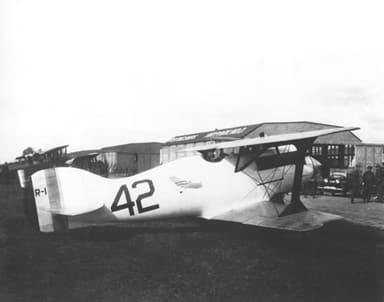
https://commons.wikimedia.org/w/index.php?search=Verville+VCP&title=Special%3ASearch&go=Go&ns0=1&ns6=1&ns12=1&ns14=1&ns100=1&ns106=1#/media/File:VERVILLE_R-1_RACER_USAF.JPG
The specification of the original, military model VCP-1 was as follows:
- Length 22.5 ft, height 8.5 ft, wing span 32 ft, wing area 269 sq ft
- Empty weight 2,069 lb, gross weight 3,005 lb, crew one
- 300 hp Hispano-Suiza 8 V-8 / Packard 1A-1237 , 350 hp
- Max 146 mph, cruise 132 mph, ceiling 19,300 ft, 11 min to 10,000 ft
JULY 1920
The United States Postal Service introduces its first transcontinental service on July 29, between New York City and British Columbia. Eddie Hubbard is the pilot and his aircraft was most likely a modified version of the Boeing Model 2.
AUGUST 1920
The British Nieuport & General Aircraft Company goes out of business together with British Aerial Transport and the Alliance Airplane Company. Historians ascribe this to the end of the war curtailing its business, and using an unsuitable motor.
SEPTEMBER 1920
Aircraft designer Geoffrey de Havilland sets up his own shop by creating the de Havilland Aircraft Company. His early achievements included the Moth biplane which revolutionised general aviation in the 1920s.
The United States Postal Service completes the final leg of its U.S. transcontinental airmail service in a De Havilland DH-4, flying across the Rocky Mountains from Omaha, Nebraska, to Sacramento, California. However, the mail travels by train at night for safety reasons.
OCTOBER 1920
The Canadian Air Board completes the first transcontinental flight in Canada, departing from Halifax, Nova Scotia on October 7, and arriving in Vancouver, British Columbia ten days later using a variety of aircraft including Felixstowe F.3 flying boats.
British Blackburn Dart Torpedo Bomber Plane
The British Blackburn Dart torpedo bomber was a private venture to replace the Sopwith Cuckoos flying from the Royal Navy’s carriers. The single seat aircraft was a large biplane with two-bay, equal-span wings that were staggered, and could fold for storage aboard ship.

https://commons.wikimedia.org/wiki/File:Blackburn_Dart_RAF.jpg
The Swift, as this version was called, had fabric covering a metal fuselage structure. The wings also had steel skeletons, although the outer portions and ailerons were wooden. Divided landing gear had main wheels on oleo, shock-absorbed legs, that allowed the fitting of a standard torpedo below the fuselage.
The first prototype almost crashed because the center of gravity was miscalculated. However, the manufacturer resolved this by sweeping back the wings, and fitting a revised rudder to improve directional control. The next flight in October 1921 was successful, and the Royal Navy ordered three for service trials.
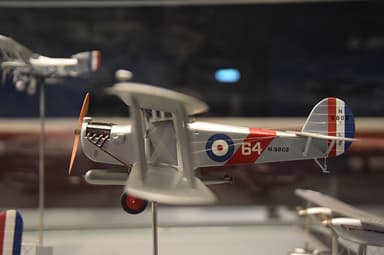
https://upload.wikimedia.org/wikipedia/commons/1/1e/Blackburn_Dart_T_II_%2832400166538%29.jpg
The Blackburn Dart and its derivatives was a successful aircraft with 118 sold in Britain, and further 8 exported to Japan, Spain, and the United States. It served the Fleet Arm and Royal Air Force until 1928, when other aircraft replaced it. However, it continued as a two-seat trainer through to 1933.
The specification of the Blackburn Dart T.2 was as follows:
- Length 35.5 ft, height 13 ft, wing span 45.5 ft, wing area 654 sq ft
- Empty weight 3,599 lb, gross weight 6,383 lb, crew one
- Napier Lion IIB W-12 water-cooled piston engine, 450 hp
- Max speed 107 mph, cruise 100 mph, stall at 43 mph
- Range 410 mi, service ceiling 12,700 ft, climb 600 ft per minute
- Fixed, forward firing Vickers machine gun
- Mark VIII or IX, 18 inch torpedo, OR two 520 lb bombs under each wing.
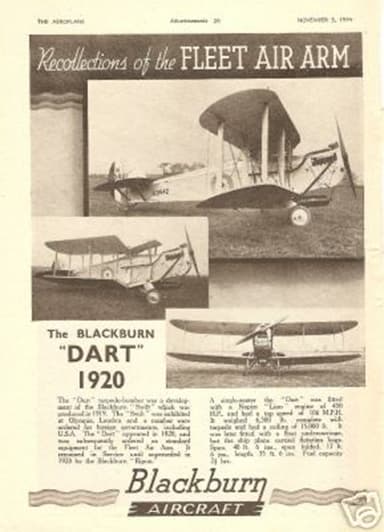
https://en.wikipedia.org/wiki/Blackburn_Dart#/media/File:Blackburn_Dart_advert.JPG
Naval Aircraft Factory TF Twin-Engine Flying-Boat Escort Fighter
The United States Naval Air Factory established in 1918 to help resolve the supply problems affecting the nation’s entry into World War 1. It developed the Naval Aircraft Factory TF twin-engine flying-boat escort fighter during 1920. Its thinking partly depended on requirements drafted by the British Technical Committee in April 1918.

https://www.flickr.com/photos/skyhawkpc/49761763548
The Naval Aircraft Factory TF-1 that resulted had a similar hull to the Curtiss NC-1, an armament of three flexible mounting Lewis machine guns, and space four crew members. However, the Bureau of Engineering revised the engine configuration into a tractor/pusher combination, because the wingspan was insufficient for a conventional two-engine tandem layout.
This experiment was unsuccessful because of continuing lowe power, and questionable air and sea worthiness following the first flight on October 13, 1920. The project was abandoned after all four prototypes failed to meet expectations. The Navy Department cancelled the project on January 11, 1923.

https://calisphere.org/item/e97210d95beb87f176c847eddac1061e/
San Diego Air and Space Museum Library and Archives
The original specification of the Naval Aircraft Factory TF-1 was as follows:
- Length 44 ft, height 15 ft, wing span 60 ft, wing area 930 square feet
- Empty weight 5,575 lb, loaded weight 8,846 lb, crew four
- Two Hispano-Suiza “Model H” in-line engines in tandem, 300 hp each
- Max speed 95 mph, cruise 72 mph, range 639 max, ceiling 13,000 ft
- Armament three flexible .30 inch Lewis machine guns
NOVEMBER 1920
Australia establishes the Queensland and Northern Territory Aerial Services Ltd on November 16. Their Armstrong Whitworth F.K.8’s were the forerunner of the future Qantas national airline.
Parnall Puffin Amphibious Fighter-Reconnaissance Biplane
The Parnall Puffin was a speculative attempt to meet RAF Specification XXI, issued in May 1919. The intention was to acquire an amphibious aircraft that could operate from land, carrier decks, or the sea. The otherwise fairly conventional biplane had a single, central float, and a vertical stabilizer and rudder mounted below the fuselage to maximize the gunner’s field of fire.
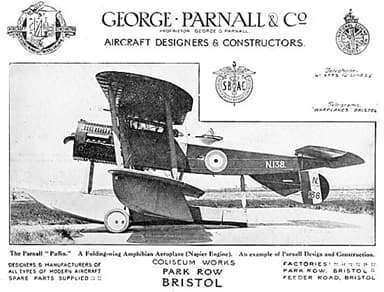
http://www.aviationancestry.co.uk/?advert/&advertId=36158
The Parnall Puffin was a two-bay biplane, with parallel chord, and equal span wings that could fold for storage. Control surfaces operated via a two-speed gear system, to optimize them for fast and slow flying.
The pilot had control of a fixed, forward firing Vickers machine gun. While the gunner behind him, whose need for an excellent field of fire had determined the tail arrangement, had the standard Scarff ring mounted Lewis gun of the time.
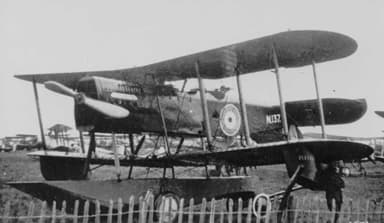
https://en.wikipedia.org/wiki/Parnall_Puffin#/media/File:Puffin2a.jpg
The Parnall Puffin completed its first flight in November 1920. It proved tail heavy, and spray from the float in heavy weather damaged the propeller. However, subsequent modifications allowed for true amphibious use. It might have sold well during the war just ended. However, the Royal Air Force was struggling to survive and the orders did not flow.
The specification of the Parnall Puffin was as follows:
- Length 30 ft, height 11.5 ft, wing span 40 ft, gross weight 5,000 lb, crew two
- Napier Lion II 12-cylinder water cooled piston engine, 450 hp, speed 110 mph
- One pilot-controlled 0.303 inch Vickers machine gun, fixed and forward firing
- One 0.303 inch Lewis gun on a Scarff ring in rear cockpit for the gunner
DECEMBER 1920
Frank Briggs completes the first east / west flight across Australia on December 16, covering a distance of 2,431 miles in a de Havilland D.H. 4 after 21 hours in the air.





